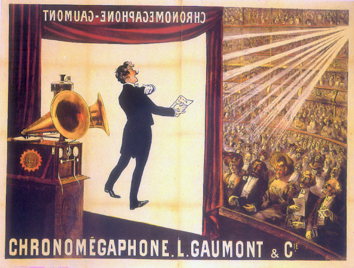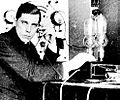Sound film facts for kids
A sound film is a movie that has sound matched perfectly with the pictures. Before sound films, movies were "silent." This meant actors couldn't speak, and any talking was shown as words on the screen. The very first time people saw sound movies was in Paris in 1900. But it took many years for them to become popular. The first short sound movie shown for money was in New York City in April 1923. Today, almost all movies you watch are sound films!
Contents
How Sound Films Began
Sound films were a big step forward in how movies were made. For a long time, filmmakers tried to add sound to their silent movies.
Early Experiments with Sound
Many inventors worked on making movies with sound. They tried to link a movie projector with a phonograph. A phonograph was a machine that played recorded sounds.
Edison's Kinetophone
One early attempt was the Kinetophone by Thomas Edison. This machine tried to combine his Kinetoscope (a viewing device for movies) with a phonograph. It was an interesting idea, but it wasn't perfect. The sound and picture often didn't stay together.
Pioneers of Sound-on-Film
Other inventors worked on different ways to add sound. Eric M. C. Tigerstedt was a Finnish inventor. He was one of the first people to work on "sound-on-film" technology. This meant the sound was recorded directly onto the film strip itself. This was a much better way to keep the sound and picture in sync.
The Rise of Commercial Sound Films
Even with these early inventions, it took a while for sound films to become popular. The technology needed to get much better.
Phonofilm and Vitaphone
In the 1920s, new systems like Phonofilm and Vitaphone appeared. Phonofilm was a sound-on-film system. Vitaphone used large records that played alongside the movie. These records were carefully timed to match the film. A Vitaphone record could play for about 11 minutes. This was enough time for one reel of film.
The Jazz Singer Changes Everything
The movie that really made sound films famous was The Jazz Singer. It came out in 1927 and used the Vitaphone system. While it wasn't the first movie with sound, it was the first to have a lot of talking and singing. People loved it! This movie showed everyone that sound films were the future.
The Impact of Sound on Movies
Adding sound changed movies in many ways. It opened up new possibilities for storytelling.
New Challenges for Actors
Silent movie actors were used to expressing themselves with their bodies and faces. With sound, they suddenly needed good speaking voices. Some actors struggled with this change. For example, Norma Talmadge was a big silent film star. But her voice didn't match her glamorous image, and her career suffered.
Filming with Sound
Making sound films was also different for the film crews. Microphones had to be hidden on set. Cameras made a lot of noise, so they had to be put in soundproof booths. This made filming more difficult at first.
Sound in Different Countries
Sound films quickly spread around the world.
- The first Soviet talkie (a movie with talking) was Putevka v zhizn (The Road to Life) in 1931.
- Japan's first big sound film success was The Neighbor's Wife and Mine in 1931.
- Brazil's first talkie was Acabaram-se os otários in 1929. It was also the first sound film in any Iberian language (like Spanish or Portuguese).
Sound Effects and Music
Sound didn't just mean talking. It also meant adding sound effects and music directly to the film. Movies like Westfront 1918 (1930) were praised for their realistic battlefield sounds. Music could now be perfectly matched to the scenes, making movies even more exciting.
How Sound is Recorded on Film
Modern sound films use a "variable-area sound track." This is a special part of the film strip.
Understanding the Sound Track
Imagine a thin white line on the side of the film. The width of this white line changes. These changes represent the sound waves. When the film goes through the projector, a light shines through this track. A sensor reads the changes in light and turns them back into sound. The wider the white area, the louder the sound.
Images for kids
-
A newspaper ad for The Jazz Singer (1927), which used Vitaphone, and a Fox newsreel, which used Movietone.
-
Dorothy Mackaill and Milton Sills in The Barker, one of the first "talkies" from First National Pictures.
-
The cover of Photoplay magazine from December 1929, featuring Norma Talmadge. Sound films changed many actors' careers.
-
A poster for The Broadway Melody (1929). This was the first sound film to win the Academy Award for Best Picture.
See also
 In Spanish: Cine sonoro para niños
In Spanish: Cine sonoro para niños
















